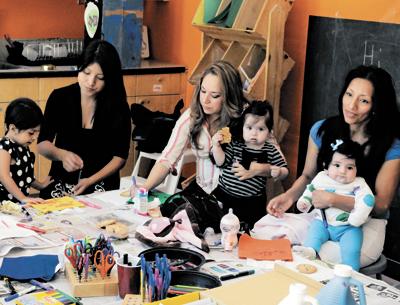Music of Assimilation at CMEE

Every Tuesday, from September until June, a handful of Latino mothers gather with their young children to participate in Cantemos, a family literacy program at the Children’s Museum of the East End in Bridgehampton.
One recent morning, eight children between the ages of 5 months and 4 years sat with their mothers in a semicircle, where they shook tambourines and maracas, waved pink and orange scarves, and wriggled their tiny bodies in time to the music.
“Your children are learning like crazy. You really have a chance to set new patterns,” said Leah Oppenheimer, who has directed the Cantemos program for the past three years. “Learning rhymes are part of learning English. Rhymes are rhymes, whether they’re in English or Spanish. When you sing to them in Spanish and they hear rhymes, it’s a really good thing.”
Organizers see the program, which is subsidized by the museum, as a badly needed resource among a population of working poor who couldn’t otherwise afford the luxury of enrolling their young children in music classes. Participants pay not a penny. On Friday mornings, CMEE also offers Music Together classes, an early childhood music program for which 10-week classes usually run upward of $200.
“All of the studies show that early intervention is vital for academic success,” said Stephen Long, CMEE’s executive director. According to Mr. Long, part of the reason behind the museum’s opening in 2005 was the deficit in educational resources on the South Fork. Cantemos, along with a new program that teaches science literacy, is working to expand those offerings among the growing Latino population.
Recent data suggest that early learning revolves around a child’s exposure to language — the more, and the earlier, when their minds are like sponges, the better. In particular, data from the late Betty Hart and Todd R. Risley, who formerly worked as University of Kansas child psychologists, showed that children of different socioeconomic backgrounds had radically divergent home lives insofar as language was concerned.
The researchers found that children whose families received public assistance heard an average of 600 words per hour, children of working-class parents heard an average of 1,200 words per hour, and a child raised in a professional home heard an average of 2,100 words an hour. By the age of 3, such a discrepancy resulted in a poorer child having heard an average of 30 million fewer words. In subsequent years, a greater number of words resulted in not only higher I.Q. scores among the wealthier children, but also far better performance in school.
In between Spanish and English renditions of “Twinkle, Twinkle, Little Star,” Ms. Oppenheimer and Barbara Blaisdell, who co-teaches the program, emphasized the importance of reading and language. Ms. Blaisdell handed out copies of two board books, “You Are My Sunshine” and “Little Ladybug.” The Target store in Riverhead donated this year’s books. Over the course of the year, each family receives upward of 20 books.
“There’s something about the small book that’s important,” Ms. Blaisdell said. “At home, if you have a box or a basket, it’s helpful to keep the books together for your children to read. It doesn’t have to be fancy. It can even be a shoebox.”
Together, the two women have spent more than 50 years making music with children. They see music as a great equalizer and useful tool for eliminating the intimidation often associated with learning a new language.
Ms. Oppenheimer, a former Music Together instructor in East Hampton who sold her business to Ina Ferrara, sees the program as providing a valuable resource to a constituency who wouldn’t otherwise be able to attend such classes. She also sees it as an extended support network for the mothers, many of whom live apart from extended family members. “Sometimes, they just need someone to tell them what a great mom they are,” she said.
Following the success of Cantemos, the Long Island Community Foundation, a Syosset-based nonprofit, provided CMEE with a $15,000 grant to expand the program from early childhood to school-age children.
Ciencia, which runs after school on Tuesday afternoons from September until June, currently enrolls 19 children from 17 families. As with Cantemos, parents and children both participate. The program’s goal is to develop a replicable national model that promotes science literacy among immigrant families. It also works to assist families in learning to navigate local education resources, whether museums, schools, or libraries. This past spring, children and parents learned the basics of natural history, developed observational skills, and studied native species and the local habitat.
After singing a goodbye song, the children and their mothers zigzagged their way to the art room, where they decorated canvas book bags with glitter, puffy paint, and fabric markers.
Fanny Espejo, a resident of Sag Harbor, has been attending with her 10-month-old daughter, Zoe, since March. “She likes dancing to the music, and I learn a lot,” said Ms. Espejo, who works in a beauty salon.
Nube Farez has taken her daughter, Kalie, since she was 2 months old. She is now 5 months. Ms. Farez, a resident of Southampton who works as a housekeeper, said Kalie loves looking at the books.
For the past two years, Yadira Luna, who lives in Sag Harbor, has taken her daughter, Mia, now 3. Ms. Luna, who worked as a doctor in her native Colombia, said she reads to her daughter in both Spanish and English, often using the books provided by the program.
“It’s good for her and it helps to open her mind to the language,” Ms. Luna said. “And it’s good for me, too, to be with the other mothers.”
